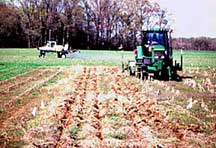
The benefits of site specific management of soil fertility have proven difficult to measure. Common sense tells one that the potential for profit should increase as the proportion of the field that varies from low soil test nutrient levels to high soil test nutrient levels increases. There is no foolproof way of predicting the extent of this variability before a decision for intensive soil sampling. Profit is expected to be gleaned from saving on fertility input costs in “high” testing areas and “increased production” in areas of low fertility once that situation is corrected by appropriate amendments. Little benefit can be realized when intensively sampled areas do not vary in soil test value from the whole field average.
Many consider yield information to be the most important part of a site-specific crop management system. In a relatively short period of time, grain yield monitors have become integral tools for many grain producers. Some estimates indicate 17,000 of these units are being used in the United States today. A routine question that producers are asked when purchasing a new combine is whether they want to add a yield monitor and GPS receiver. A yield monitor equipped with GPS is necessary for making spatially varying yield maps. Today an increasing number of cotton producers are asking that question, thanks to a yield monitoring technology developed at the station which has ushered in important precision agriculture tools to cotton production.
